#sotoba komachi
Text

“MAN A
What a lovely voice. It's clear, like the voice of a fountain.
WOMAN A
It's a lesson in eloquence just to hear her talk to herself.”
- Yukio Mishima, ‘Sotoba Komachi’ (1956)
2 notes
·
View notes
Text



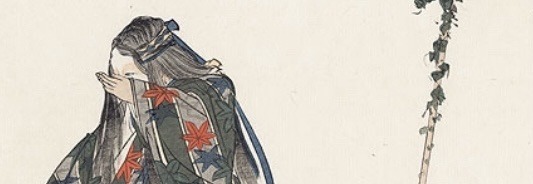

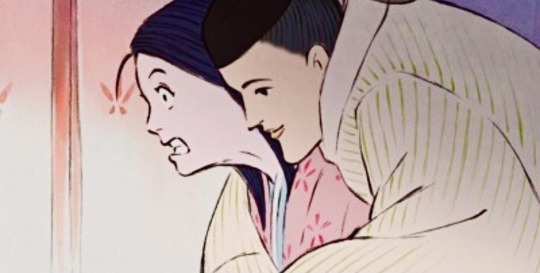
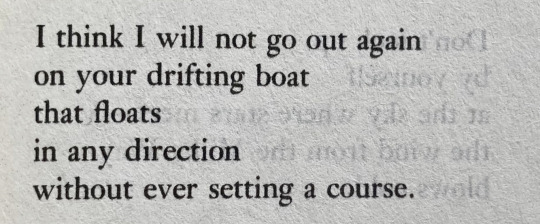



Women rejecting male suitors in premodern Japanese literature
‘Sotoba Komachi’ (14th century) by Kan'ami Kiyotsugu, trans. Donald Keene • Scene from It Was a Faint Dream (1974) dir. Akio Jissôji (based on Towazugatari (1306) by Lady Nijo) • The Tale of Genji (~1010) by Murasaki Shikibu, trans. Royall Tyler • Detail from Unai appearing as a young maiden (from Motomezuka, Act 1) by Tsukioka Kogyo (1900) • The Tale of the Bamboo Cutter (9th century) by Anonymous, trans. Donald Keene • Kaguya rejecting the emperor in The Tale of Princess Kaguya (2013) dir. Isao Takahata (based on The Tale of the Bamboo Cutter) • Untitled poem by Izumi Shikibu (11th century) trans. Jane Hirshfield and Mariko Aratani • Kagero Nikki (~974) by Michitsuna’s Mother, trans. Donald Keene • Utsusemi from "Fifty-four Chapters of The Tale of Genji” (1852) by Utagawa Hiroshige • Untitled poem (9th century) by Sosei, trans. Kenneth Rexroth
#classical japanese literature#japanese literature#japanese poetry#books#literature#classical literature#medieval#medieval literature#web weaving#ellis reads#the tale of genji#izumi shikibu#murasaki shikibu#ono no komachi#tale of genji#genji monogatari#sosei#the tale of the princess kaguya#i was thinking about how unusual it is to find a classical literary culture that so prominently features female rejection of male courtship#it appears in so many places. young women rejecting elegible suitors. wives rejecting husbands. lower rank women rejecting princes.#female rejection became a key part of the social and literary code#these rejections weren’t always respected by the suitors or condoned by the authors writing them or those around them#but they were nevertheless recorded and thus immortalised#and so we can remember michitsune’s mother not just as a passive victim of a patriarchal system but as one who asserted her agency to say no#circumstances made her powerless in many ways but she still exists and asserts her selfhood through her memoirs#it’s just. incredible and humbling#also ik Ukifune isn’t anywhere on this but she was the inspiration for it <3 thinking about her always
215 notes
·
View notes
Photo

古書店でようやっと購入。太田省吾さんの「小町風伝」。
2020年10月から続けているジャカルタのBambang Prihadiの劇団 Lab Teater Ciputatとの長期国際共同制作にどうしても必要な気がして。
というのもこの共同制作が、shelfがインドネシアの作家ダナルトの小説「Rintrik」を、LTCが三島由紀夫の「卒塔婆小町」を題材に、それぞれお互いの国の先行する文学テキストを交換するかたちでそれぞれ舞台制作をし、出来上がった2作品をベースに新しく共同制作、共同演出作品を作るというものだからだ。(CROSSING TEXT: というプロジェクトタイトルにある言葉はここに由来する。)
共同制作の難しさはたくさんある。だが敢えて二つ“このプロジェクトの”困難さを挙げるとすると、
インドネシアで広く題材として扱われ続けている「Rintrik」の作家ダナルトのスーフィズムあるいはケジャウェンという土着宗教に影響を受けたイスラム思想を日本人がどう受容するか。またそのような、一種異端の思想とも言えるダナルトの書いた物語がなぜ繰り返しインドネシアの芸術家たちを惹きつけて来たか。
ということと、三島の書いた「卒塔婆小町」のその向こうにある三島の思想はもちろん、観阿弥作の「卒塔婆小町」のそれ以外にも/以前から日本に数多のバリアントがある小町伝説や、そも、何故かくも「卒塔婆小町」という題材が日本人を惹きつけて来たか。ということをも、創作の射程に入れなければならないという点ではないかと思っている。
難しい。しなければならないリサーチは果てしない。(だがその結果が研究発表になってはつまらない。)
来週、僕らは2020年10月に初演したshelfの「Rintrikーあるいは射抜かれた心臓」をジャカルタに持って行く。(その後対面では初めての共同作業、クリエイションを1週間、LTCのメンバーと行う予定だ。)楽しみと、不安の入り混じるこの本番前の感覚はキライじゃない。
まずは日本人が作った「Rintrik」が、ジャカルタでどう受け取られるか。日本での稽古はあと6日間。稽古場では毎日、創作と、今も題材に関するディスカッションが続いている。
Bought at an old bookstore. "Komachi Fuden" by Shogo Ota.
I feel that it is absolutely necessary for this long-term international collaboration with Bambang Prihadi's theatre company Lab Teater Ciputat, which has been ongoing since October 2020.
This joint production is based on Indonesian author Danarto's short story "Rintrik" and Yukio Mishima's "Sotoba Komachi" and two theatre companies exchanging these preceding literary texts from each other's countries and creating a theatre piece. But it's just the first step. Next, we involve creating a new co-production/co-directing work based on the two completed works. (The word CROSSING TEXT: comes from here in the project title.)
Of course, there are many difficulties in international collaboration. However, if I dare to mention two difficulties of "this project",
How do we (can we) Japanese members accept the Islamic thought of Danarto the writer of "Rintrik" especially influenced by Sufism or Kejawen, the indigenous religion? This short story continues to be widely used as a subject of theatre work in Indonesia. Also, why has the story written by Danarto, which can be said to be a kind of heretical thought, repeatedly attracted Indonesian artists?
One more, Mishima's thoughts behind "Sotoba Komachi" written by Mishima, as well as Konami's "Sotoba Komachi" / Komachi legends that have had many variations in Japan since before Why, then, has the theme of 'Sotoba Komachi' attracted so many Japanese?
This is also a point that must be included in the view of creation.
It's difficult. The research I must do is endless. (However, it would be boring when the results were shown as like research papers.)
Next week, we'll bring shelf's "Rintrik - or the Pierced Heart", which premiered in October 2020, to Jakarta. (After that, we're planning to do our first face-to-face collaboration and creation with LTC members for a week.) I like this mixed feeling of excitement and anxiety before the performance.
How the Japanese-made “Rintrik” will be received in Jakarta? Six more days of rehearsing in Tokyo. We continue to create and discuss themes every day in the rehearsal room.
#Crossing text: International collaboration project between Tokyo and Jakarta#Danarto#三島由紀夫#卒塔婆小町#小町風伝#太田省吾#Rintrik
3 notes
·
View notes
Photo

Sotoba Komachi, from the series "One Hundred No Dramas (Nogaku hyakuban)", Tsukioka Kôgyo, 1893, Art Institute of Chicago: Asian Art
Bequest of Henry C. Schwab
Size: Approx. 37.8 x 25.6 cm (14 7/8 x 10 1/8 in.)
Medium: Color woodblock print
https://www.artic.edu/artworks/154636/
32 notes
·
View notes
Photo
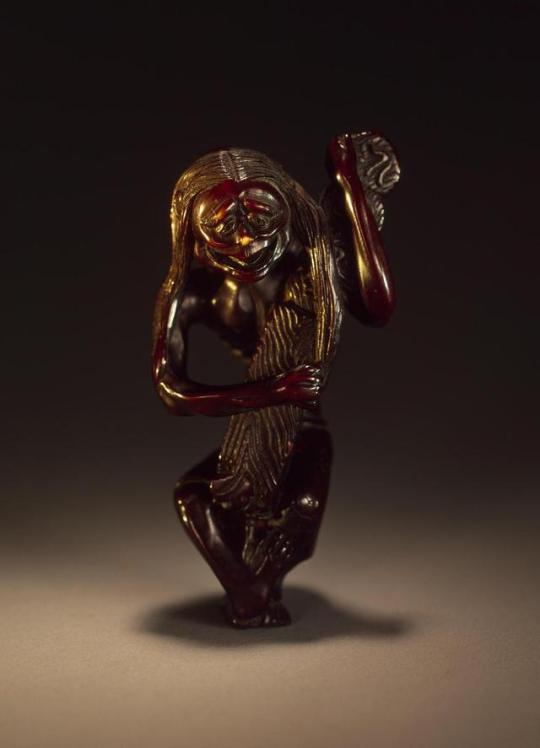
Netsuke: Sotoba-Komachi
Place of creation: Japan
Master: Shukosai Anraku
Date: First half of the 19th century
School: Osaka
Material: painted ivory
The subject of Sotoba-Komachi (Komachi and the Sotoba Tomb) is associated with the last years of the 9th-century poetess and lady-in-waiting Ono-no Komachi. She was celebrated not only for her verse but also for her beauty and cruel treatment of her suitors. In her old age she, no longer beautiful, left the court and ended her days as a wandering beggar. Stories of her enigmatic life became very popular in art, and first of all in theatrical interpretations. Sotoba (the Sanscrit for "stupa") is a Buddhist symbol that was also used as a tombstone. The play is about the meeting of the wandering old Komachi with two monks. They entered into a dispute at the end of which Komachi told her life story, explaining her hard fate as a retribution for her cruelty towards her lovers.
The State Hermitage Museum
5 notes
·
View notes
Photo
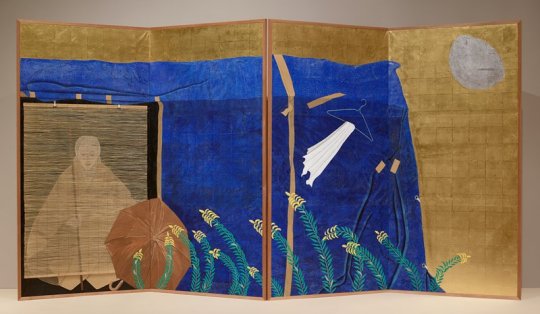
Blue Sheet and Yellow Flowers [right of a pair], Yamamoto Tarō, 2008, Minneapolis Institute of Art: Japanese and Korean Art
two-fold screen; hanging blue sheet at left; white cloth on wire hanger, ULQ; some yellow flowers at bottom edge; gold at right, with white form in URC The figure in the screen references Ono no Komachi, a famously beautiful waka poet from the Heian period who became a popular character in Noh theater. In the play Sotoba Komachi (Komachi on the Stupa), the poet devolves into a haggard beggar wandering the countryside, a storyline that Tarō adapted to a contemporary setting. Though she sits in a blue tent of the sort erected in Japanese parks today by the homeless, Komachi retains an ethereal beauty, clothed in layers of blankets or perhaps the robes of the Heian court. A deferential reference to Japanese culture, the work is also a critique of Japanese disregard for the country’s growing homeless population.
Size: 66 1/2 × 65 1/2 in. (168.91 × 166.37 cm) (image) 68 × 67 in. (172.72 × 170.18 cm)
Medium: Ink and color on gold leaf
https://collections.artsmia.org/art/118686/
1 note
·
View note
Text

Day 40 of 100 days of productivity
18년10월1일 HAPPY OCTOBER/AUTUMN 🎃
I have a test in my interpersonal communications class soon so I'm trying to study lol. I also have to read Sotoba Komachi by Thursday and finish my dramaturgical file by Thursday too. I don't have much time to study Korean but I at least throw in some Memrise here and there and I want to get back on track with ttmik ESPECIALLY now they renovated their website and it's SO NICE!
Sorry I've been MIA school is hard ya'll. But it's fun and stuff too yay.
화이팅 ♡
#langblr#korean#studyblr#language study#college#foreign languages#100 days of productivity#study blog
11 notes
·
View notes
Text
-- One thought can sow salvation in the heart.
-- If your heart has seen salvation, how comes it that you linger in the World ?
-- It is my body that lingers, for my heart left it long ago.
-- Kan'ami Kiyotsugu (1333-1384), from “Sotoba Komachi”
3 notes
·
View notes
Photo

Pertunjukan Teater Sotoba Komachi Yang Membius Penonton
Pada tanggal 11 Agustus 2017 lalu, tim Japanese Station mendapatkan undangan untuk menyaksikan pertunjukan teater dengan nama Sotoba Komachi yang bertempat di kampus ISBI Bandung. Pertunjukan teater tersebut adalah ujian akhir para mahasiswa ISBI jurusan teater. Uniknya, pertunjukan teater ini diperankan oleh dua orang, yaitu Shofa Sophiyah dan Riki Dwi Mustopa, dengan pembimbing Rachman Sabur S.Sn M.Sn.
Teater Sotoba Komachi ini menceritakan tentang Komachi, seorang nenek berusia 99 tahun yang sedang duduk di bangku taman dan bertemu dengan penyair muda yang sedang mabuk. Penyair tersebut bercerita tentang karirnya, akan tetapi si penyair itu benci dengan keberadaan nenek Komachi karena menakut-nakuti pasangan muda yang menjadi inspirasi sang penyair.
Nenek tersebut mengatakan bahwa karya penyair tersebut tidak realistis yang membuat si penyair itu marah, lalu si penyair menanyakan balik kepada Komachi tentang masa mudanya dulu. Nenek Komachi pada masa mudanya disukai oleh seorang kapten kapal, akan tetapi mereka tidak memiliki hubungan istimewa. Si penyair itu lalu berakting menjadi kapten kapal tersebut dan berdansa di taman.
Setelah mereka berdansa di taman, lambat laun si penyair melihat Komachi menjadi berbeda. Keriput pada raut wajahnya menghilang, bau yang tidak sedap pun menjadi wangi. Tubuh bungkuk nenek Komachi tersebut menjadi seksi, pakaiannya yang lusuh menjadi bagus dan rapi.
Komachi bercerita bahwa setiap orang yang mengatakannya cantik maka ia terkena kutukan dan melarang si penyair untuk mengatakan bahwa dirinya cantik. Namun karena jatuh cinta, penyair itu mengatakan bahwa nenek Komachi itu cantik dan membuat umur si penyair menjadi pendek. Setelah itu si penyair meninggal terkena kutukan yang telah dikatakan oleh nenek Komachi.
Berikut adalah foto-foto dokumentasi teater Sotoba Komachi.
Image: Afrizal
Image: Afrizal
Image: Afrizal
(Featured image: Afrizal)
The post Pertunjukan Teater Sotoba Komachi Yang Membius Penonton appeared first on Japanese Station.
0 notes
Text
Only human beings really change. Even after eighty years, a daisy will still be a daisy.
-Yukio Mishima
2 notes
·
View notes
Text
Noh Reflection
1. Discuss what you think the role of Buddhism is in the play Sotoba Komachi. How did you attempt to incorporate these ideals into your performance?
Buddhism plays an important role in Sotoba Komachi because it is based upon and evolves around buddhist beliefs/customs. This means that, throughout the play, characters are constantly mentioning how much they worship/cherish Buddha for he is their one and only God. An example of this would be the Chorus, who as soon as they begin to have word of voice in the performance, remind the audience, in an exaggerated manner, about the role of Buddha:
“Between Buddha and Man
Is no distinction, but a seeming of difference planned
For the welfare of the humble , the ill-instructed,
Whom he has vowed to save.”
The first time we rehearsed the play, the Chorus sounded awful. We had began to unintentionally sound like robots due to not knowing how to carry our voices in this new, strange group character. In order to give it some life, I think it was that, as a harmless joke, we decided to add seriousness to what the Chorus was saying by having everyone in the group use their deepest, hardest inner voice. We had to be careful when doing this and practice lots so we’d be in synch and we did not sound like we were mocking the role of Buddhism. Acting responsibly and respectfully towards the beliefs mentioned by our character, even if they weren’t necessarily meaningful to us, is the way the Chorus chose to incorporate Buddhism in our performance.
2. Look at the video of your performance here: https://www.youtube.com/watch?v=PKjQyBazGOc&feature=youtu.be (Sorry it is sideways). Choose a two minute section that shows your contributions to the overall project.
I consider my biggest contribution to have happened from minute 9:03-11:03
3. Describe what you did to develop the play for performance as exemplified in this section (try to include performance and production elements). Your research into Noh Theatre should be included in this response.
In this section you can see the Chorus’ longest and most powerful monologue in the whole performance. Some performance/production elements I used to show the Noh Theatre techniques are:
The use of strong, exaggerated makeup looks in order to convey the typical Noh masks
Chorus sat down on pillows at the left side of the stage and remained there during the presentation
Through our strong voices, we helped narrate the story of Sotoba Komachi
4. Explain why your work on this project was important for it to be successful.
My work on this project was important for its success because I was in charge of the make up design, which was crucial in order to exemplify the Noh Theatre conventions in our final performance. This was my first time working as a makeup artist and I had very little time to decide how I would do it (I even ended up needing helpers because it was too much for me to handle on my own). Make up was a challenge for me because I am not an artist and I have difficulty working with my hands, creating lines, etc. However I had to put this past me when I decided to take a risk and be the play’s makeup designer.
Another challenge I faced was not having time to make the masks; I had to plan how I would still incorporate the use of masks in our play, without having the time to make the actual masks. I decided to copy the design of the stereotypical Noh masks I found when enduring my research:

And so I colored the actors’ full face with white paint, stained their lips red, eye lined their eyes with black and drew thin eyebrows on them.
Make up adds the feel of Noh to the performance, it differs it from typical theatre and sets it in Asia. It also helps the actors get into character.

Finally, I don’t think the Chorus would’ve been the same without me because it was Gibby and I who teamed up and worked together to improve the Chorus.
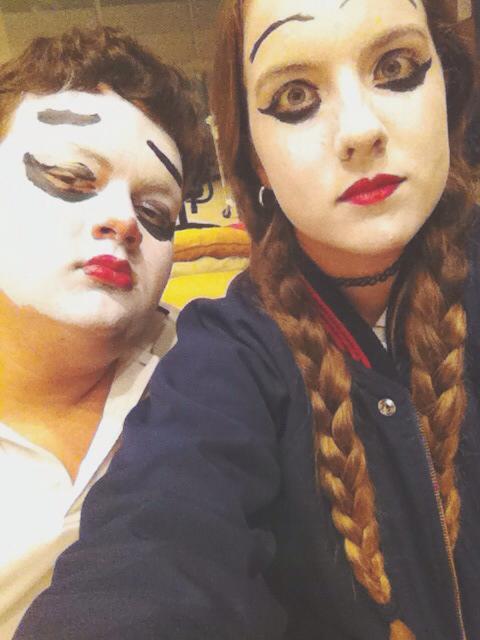
5. How did you adapt the performance due to resources and time?
There were many adaptations we had to do to the performance due to resources and time. First of all we allowed everyone in the group to use scripts and limited the costume design to one prop per actor (if desired). The set design was also limited. On another hand, we had only one musician (Melanie) and the Chorus was incomplete (its supposed to be made up of 8 people). Sometimes the Chorus and I would step out of class and practice being in synch. I took charge and directed the actors who weren’t keeping up the pace with me and Gibby. I’m sure if we would’ve have more time, the Chorus could’ve sounded better, more powerful and on synch.
When doing everyone’s makeup, I had to look for make up helpers because it was too much work for me to do on my own. It would’ve been cool if we had times to make masks, but it was also good we didn’t because it gave the performance a certain uniqueness; how instead of having the actors wear a mask, they had one painted on their faces.

6. What conventions of Noh Theatre appeal to you as a practitioner? How might you use these in your work in the future?
Some conventions involving Noh Theatre that appeal to me as a practitioner are the masks, which even though I was able to work with during this project, I would’ve enjoyed having the time and resources to be part of the process of making a mask that suited each character’s personality. The Chorus was also a very interesting part of this theatre style to work with. I learned to use my voice. I would now like to research Noh music, because sountrack choice is something I feel passionate about.
In my future work, I may apply my learnings by, on a future project (like the Director’s Notebook) choosing to focus on a typical Noh Theatre play and analyzing its conventions with more time, and therefore in more depth.

#11Arts#Sotoba Komachi#Noh#11Theatre#Reflections#Conventions#Reflection#Drama#Noh Theatre#Video#Pictures#Class
0 notes
Text
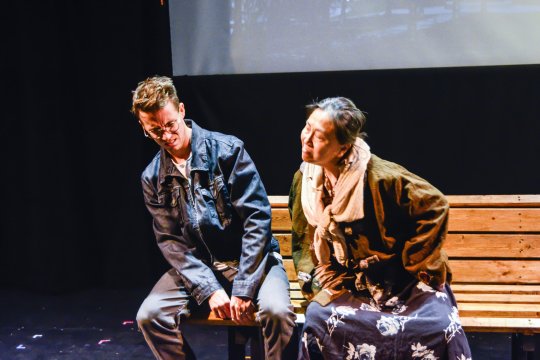
"Two Modern Noh Plays" by Yukio Mishima presented by Midtwenties Theater Society & 2019 Vancouver Fringe Festival
“POET: Listen to me. . . . I am just what I seem, a threepenny poet, without even a woman who'll look at me. But there's something I respect-the world as reflected in the eyes of young people who love each other, a hundred times more beautiful than what they actually see—that I respect. Look, they're not the least aware we're talking about them. They've climbed up high as the stars. You can see the glint of starlight under their eyes, next to the cheeks. . . . And this bench, this bench is a kind of ladder mounting to heaven, the highest lookout tower in the world, a glorious observation point. When a man sits here with his sweetheart he can see the lights of the cities halfway across the globe. But if (climbs on the bench) I stand here all by myself, I can't see a thing. . . . Oh, I do see something—lots of benches, somebody waving a flashlight—must be a policeman. A bonfire. Beggars crouching around the fire. The headlights of a car. They've passed each other now and are heading toward the tennis courts. What was that? A car full of flowers. Performers returning from a concert? Or a funeral procession? (He gets down from the bench and sits.) That's all I can see.
OLD WOMAN: What rubbish. Why in the world do you respect such things? It's that same silly nature of yours which makes you write sentimental poems that nobody will buy.
POET: And that's exactly why I never invade this bench. As long as you and I are occupying it, the bench is just so many dreary slats of wood, but if they sit here it can become a memory. It can become softer than a sofa, and warm with the sparks thrown off by living people. . . . When you sit here it becomes cold as a grave, like a bench put together out of slabs of tombstones. I can't bear that.
OLD WOMAN: You're young and inexperienced, you still haven't the eyes to see things. You say the benches where they sit, those snotty-faced shop clerks with their whores, are alive? Don't be silly. They're petting on their graves. Look, how deathly pale their faces look in the greenish street light that comes through the leaves. Their eyes are shut, the men and women both. Don't they look like corpses? They're dying as they make love. (Sniffs around her.) There's a smell of flowers, all right. The flowers in the park are very fragrant at night, just like those inside a coffin. Those lovers are all buried in the smell of the flowers, like so many dead men. You and I are the only live ones.
POET: (Laughs.) What a joke! You think you're more alive than they are?
OLD WOMAN: Of course I do. I'm ninety-nine years old, and look how healthy I am.
POET: Ninety-nine?
OLD WOMAN: (turning her face into the light) Take a good look.”

“OLD WOMAN: I know what the face looks like of someone who's come back to life—I've seen it often enough. It wears an expression of horrible boredom, and that expression is what I like. . . . Long ago, when I was young, I never had the sensation of being alive unless my head was all awhirl. I only felt I was living when I forgot myself completely. Since then I have realized my mistake. When the world seems wonderful to live in, and the meanest little flower looks big as a dome, and flying doves sing as they go by with human voices . . . when, I mean, everyone in the whole world says "Good morning" joyously to everyone else, and things you've been searching for ten years turn up in the back of a cupboard, and every girl looks like an empress . . . when you feel as if roses are blooming on the dead rose trees, then—idiotic things like that happened to me once every ten days when I was young, but now when I think of it, I realize I was dying as it happened. . . . The worse the liquor, the quicker you get drunk. In the midst of my drunkenness, in the midst of those sentimental feelings and my tears, I was dying. . . . Since then, I've made it a rule not to drink. That's the secret of my long life.
РОЕТ: (teasing her) Oh! And tell me, old lady, what is your reason for living?
OLD WOMAN: My reason? Don't be ridiculous! Isn't the very fact of existing a reason in itself? I'm not a horse that runs because it wants a carrot. Horses, anyway, run because that's the way they're made.”
- Yukio Mishima, ‘Sotoba Komachi’ (1956)
#mishima#yukio mishima#sotoba komachi#noh plays#Midtwenties Theater Society#Vancouver Fringe Festival
2 notes
·
View notes
Photo









Day 3. 12月13日(火)
忘れないうちに振り返り日記を。
この日は、Bambangが以前、shelfの俳優とLTCの俳優とが1対1で、Facebookメッセンジャーを介して制作したダイアログを彼なりに編集していてそれを最後までやってしまいたいというので、一日かけて矢野がワークショップを担当。
午前中は、感覚を開くプログラム。視点をまっすぐ正面に据え置きつつ、視野を出来るだけ広げる。左右上下、自分を取り巻環境が、世界がどレほど広く見えているか。自分の指を使ってそれを確かめつつ。その感覚を保持しつつ、同時に自分の周りをまわる小さな人工衛星をイメージして、その衛星から自分の身体を隅々まで観察する。さらに、最初の感覚と、その衛星から観察されている感覚を同時に保持しつつ、ゆっくりと3歩前へ向かって歩いて、ターンし、元の位置に戻ってもう一度正面を向く。
この立ち方が、shelfの舞台での立ち方の基礎になっていると説明しつつ、Bambangの眼の使い方についてのメソドロジーとの���いをどう受け止めたか。俳優たちと話し合い、共有する。三橋さん曰く、Bambangのメソッドがダイナミックで��い集中、強固なフォーカスを求めるのだとしたら、shelfのメソッドは意識を分散させるというか、視野を広くとって、ぼやかせるようなそんな方法だと私は認識している、と。面白いことを仰っていた。
午後は事前に、といっても当日の朝早くにだけど、抜き出して送っておいた「卒塔婆小町」の台詞を日本語とインドネシア語でそれぞれのカンパニーの俳優同士が組んで、何回か繰り返して対話を行った。みんな台詞をきちんと覚えてくれていたので、僕も彼ら一人ひとりの演技を見ることに集中できた。
基本にしたのは、台詞の(言葉の)意味ではなく、発語の背後にある人間の衝動や感情、目的を相手の身体から感じ取ること。そしてそれに応答すること。自分の(発語)行為、アクションを、相手のアクションに対するリアクションにして、あるいは自分自身の発した言葉をよく聞いて、それに対するリアクションとして次のアクションを起こすこと。自分のアクションについては、自分自身や、相手がそれに対してリアクションを取りやすいよう、出来るだけアクションの輪郭を明確にすること。大げさな、オーバーなアクションをする必要はない。とにかく良く聞き、良く観察すること。
どれも基本的なことなので、プロフェッショナルな俳優にとっては今さらなことかも知れないけれど、自分が解さない言語を発する相手とのダイアログを成立させるために、きっといつも以上に繊細な作業が必要になると思って、そのことを今一度丁寧に実践してみた。
ちなみに引用した台詞は下記。
1 詩人 僕は今すぐ死んでもいい。一生のうちにそんな折は、めったにあるものじゃないだろうから、もしあれば今夜に決まっている。
2 老婆 つまらないことを仰言いますな。
3 詩人 いや、今夜に決まっている。もし今夜を他(よそ)の女たちとすごしたように、うかうかしすごしてしまったら、ああ。考えただけでもぞっとする。
4 老婆 人間は死ぬために生きているのじゃございません。
5 詩人 誰にもそんなことは分からない、生きるために死ぬのかも知れず……。
6 老婆 まあ、俗悪だわ! 俗悪だわ!
7 詩人 助けて下さい。どうすればいいのか。
8 老婆 前へ……前へお進みになるだけですわ。
1 PENYAIR Saat ini aku merasa siap mati sekarang juga. Saat seperti itu tidak akan datang dua kali dalam hidup manusia. Maka kalau itu terjadi di hidupku, itu pasti malam ini.
2 PEREMPUAN TUA Jangan kau mulai lagi beromong-kosong.
3 PENYAIR Mesti itu tejadi malam ini atau tidak sama sekali. Oh, aku bisa merinding kalau terpikir bagaimana aku melampaui malam ini dengan biasanya seperti malam-malam yang aku pernah melewati bersama perempuan-perempuan lain.
4 PEREMPUAN TUA Manusia hidup bukan untuk mati.
5 PENYAIR Siapa yang tahu persis tentang itu? Boleh jadi manusia mati untuk hidup....
6 PEREMPUAN TUA Itu pikiran yang dangkal! dangkal sekali!
7 PENYAIR Tolonglah aku. Menurutmu, apa yang harus kulakukan?
8 PEREMPUAN TUA Majulah... kamu harus terus maju dalam hidupmu.
この日の夜は、LTCのメンバー、shelfのメンバーみんなと一緒に大勢で、リトルトーキョー近くの屋台が並んでいるところで夕食。物乞いなんだけど、エンターテイナーなお婆ちゃんの歌い手や、伝統楽器を巧みに奏でるお爺ちゃんたちが立ち寄ってみんなでチップを渡したりして。実に楽しい夜でした。
Make a diary to look back on before I forget.
Bambang said that he wanted to finish editing and compiling the dialogues that the actors of LTC and shelf had produced via Facebook messenger one-on-one with each other before, so I oversaw the workshop for the day.
A program for opening the senses, in the morning.
Keep your eyes straight ahead and widen your field of vision as much as possible. Left, right, up and down, the surrounding environment, and how wide the world seems to be. Checking it with your finger. While maintaining that sensation, imagine a small artificial satellite revolving around you, and observe every corner of your body from that satellite.
Then, while simultaneously holding the initial sensation and the sensation being observed by the satellite, slowly walk three steps forward, turn, return to the original position, and face forward again.
While explaining that this way of standing is the basis of the shelf's way of standing on stage, how did you perceive the difference from Bambang's method of using eyes? Discuss and share impressions and ideas with actors.
According to Mako, if Bambang's method seeks dynamic and strong concentration and strong focus, the shelf's method is to disperse consciousness or to broaden the field of view and blur it. She recognizes it like that. You said something interesting, Mako.
In the afternoon, we repeated dialogue with lines from "Sotoba Komachi" several times, making the pair of a Japanese actor and an Indonesian actor, and both speaking their own mother lang.
Although in advance, early in the morning of the day, I sent those lines of "Sotoba Komachi" that I had quoted, everyone memorized the lines properly, so I was able to concentrate on watching each of them perform.
The basic idea is to sense the human impulses, emotions and aims behind the utterances from the other person's body, rather than the meaning of the lines (words). And respond to it. Making your own speech act or action into a reaction to the other person's action. listening carefully to your own words and taking the next action as a reaction to it. As for your actions, make the contours of your actions as clear as possible so that you and your opponent can easily react to them. There is no need to make exaggerated or over-the-top actions. Listen well and observe well.
These are all basic things, so it may be enough for a professional actor, but I think it will be necessary to do more delicate work than usual to make a dialogue with someone who speaks a language you don't understand. So, I tried to practice it carefully this time.
The quoted lines are below.
1 POET I had just as soon die now, at once. Such an occasion hardly ever comes even once in a lifetime, and if it is no come for me, it will be tonight.
2 OLD WOMAN Please do not weary me with such nonsense.
3 POET Tonight, it will be. And if I should spend tonight in thoughtless pleasure, as I have with other women- I shudder at the thought.
4 OLDWOMAN Man does not live simply in order to die.
5 POET Nobody knows man dies in order to live.
6 OLD WOMAN How commonplace. How dreadfully ordinary.
7 POET Help me, what shall I do?
8 OLD WOMAN GO Ahead- you can only go ahead.
That night, I had dinner with LTC and shelf members in a large group near Little Tokyo in Jakarta. They are beggars, but entertainers grandma singers and grandpa who skillfully play traditional instrument stop by and everyone give them tips. It was a fun evening.
1 note
·
View note
Photo

Sotoba Komachi, from the series "Pictures of No Performances (Nogaku Zue)", Tsukioka Kôgyo, 1893, Art Institute of Chicago: Asian Art
Frederick W. Gookin Collection
Size: Approx. 25.2 x 37.4 cm (10 x 14 4/3 in.)
Medium: Color woodblock print
https://www.artic.edu/artworks/154974/
10 notes
·
View notes
Text

“Man B: All I have is an espoir. A hope, that is.
Man A: If there's such a thing as the espoir of a sardine, I have it too. Poor fish.
Man C: Me too. (He bursts into loud laughter.)”
- Yukio Mishima, ‘Sotoba Komachi’ (1956)
2 notes
·
View notes
Photo

Sotoba Komachi, from the series "Pictures of No Performances (Nogaku Zue)", Tsukioka Kôgyo, 1893, Art Institute of Chicago: Asian Art
Frederick W. Gookin Collection
Size: Approx. 25.2 x 37.4 cm (10 x 14 4/3 in.)
Medium: Color woodblock print
https://www.artic.edu/artworks/154974/
5 notes
·
View notes